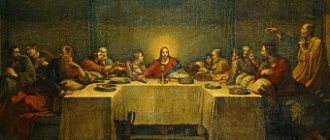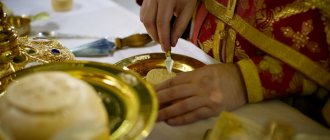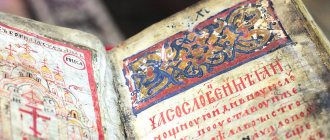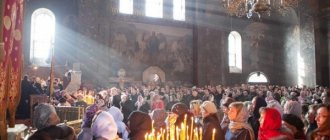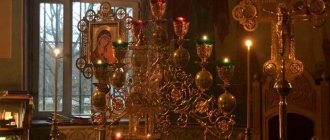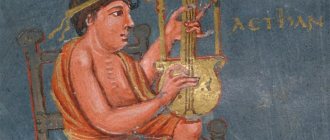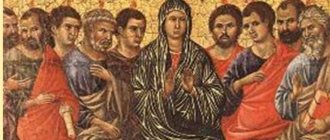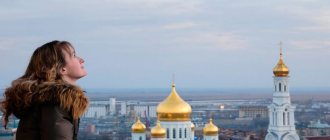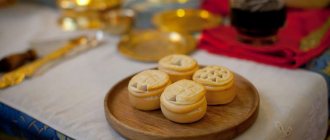The concept of Liturgy and its origin
The first place among church services is occupied by the Liturgy. During the Liturgy, the Most Holy Sacrament of Communion is celebrated, established by our Lord Jesus Christ on Thursday evening, on the eve of the Passion of the Cross.
Having washed the feet of His Disciples to set an example of humility, the Lord took bread, blessed it, broke it and gave it to the Disciples, saying: “Take, eat, this is My Body,” then He took a cup of grape wine and, praising God, gave it to the Disciples, saying: “Drink of it, all of you, for this is My Blood of the New Testament, which was shed for many for the remission of sins.” (Matt. XXVI, 26–28).
Having given communion to the Apostles, the Lord gave them the commandment to always perform this Sacrament: “Do this in remembrance of Me.” (Luke XXII, 19; 1 Cor. XI, 24).
The apostles actually performed Holy Communion according to the commandment and example of Jesus Christ and commanded to perform the Sacrament of Holy Communion in every newly emerging Christian community.
At first, the ritual and order of performing the Liturgy were transmitted orally, then a written presentation of the Liturgy began to appear. The liturgy little by little began to be enriched with new prayers, chants and sacred actions.
The Liturgy has always been celebrated and will be celebrated until the end of time in the Church of Christ, for through Holy Communion we enter into unity with Jesus Christ and are cleansed of our sins. The very word Communion or Communion, that is, communication and participation, means that thanks to this Sacrament we enter into communion, firstly, with Jesus Christ and, secondly, with each other.
The first communion is spoken of in the words of Jesus Christ: “He who eats My Flesh and drinks My Blood abides in Me, and I in him” (John VI, 54–56); about the second - in the words of the Apostle Paul: “There is one bread, one body we are many; for of one body we partake” (1 Cor. X, 16, 17).
The first part of the Liturgy Proskomedia or “Offering”
The first part of the Liturgy, in which the substance for the Sacrament is prepared, is called “offering,” because at the appointed time, ancient Christians brought bread and wine for the Eucharist, which is why the bread itself is called “prosphora,” that is, “offering.”
The substance for the Sacrament is bread and wine. The bread must be leavened (risen), pure, wheat. The bread must be leavened, and not unleavened, because the Lord Jesus Christ Himself took leavened bread to perform the Sacrament. Wheat bread is also taken following the example of Jesus Christ and also because Jesus Christ compared Himself to a grain of wheat (John XII: 24).
In appearance, bread (prosphora) consists of:
- of two parts joined together to designate the two natures of Jesus Christ - Divine and human.
- with the designation of a cross as a sign that this bread is intended for sacred use,
- with the inscription on the sides of the cross Christ the Victorious.
The wine must be grape and red, because Jesus Christ Himself consumed grape wine at the Last Supper. In Proskomedia, when remembering the suffering of the Savior, wine is combined with water, signifying that during the Suffering of the Savior, blood and water flowed from His pierced rib.
For Proskomedia, five loaves or prosphoras are used, but actually for Communion one (the Lamb) is used, as the Apostle says: “One bread, one body we are many: for we all partake of one bread” (1 Cor. X, 17).
General outline of Proskomedia
After vesting (the vesting of the clergy before the Liturgy is done after reading some of the prescribed prayers, in front of the Royal Doors, which is called “performing the entrance”) in all sacred vestments and uttering the initial “exclamation” for the reading of the hours by the psalmist, the priest proceeds to the altar.
Having made three prostrations before the altar with a prayer for the cleansing of sins, the priest takes the first prosphora and with a copy makes the sign of the cross on it three times, saying: “In remembrance of the Lord and God and our Savior Jesus Christ.” This means: we begin to celebrate the Liturgy according to the covenant of Jesus Christ and in remembrance of Him. Then, pronouncing the prophetic words of the prophet Isaiah, the priest makes a cut with a copy on four sides of the middle of the prosphora.
This is how the cubic part of the prosphora stands out and is called the Lamb. The priest places this cubic part (called the Lamb) taken from the prosphora on the paten, cuts the seal crosswise on the opposite side, while pronouncing the words: “One soldier with a copy of His side was pierced and blood and water came out” (John 19:34).
In accordance with these words, wine combined with water is poured into the cup. Having completed the preparation of the Holy Lamb, the priest takes out particles from the following prosphoras.
A particle is taken out of the second prosphora in honor and memory of our Most Blessed Lady Theotokos and Ever-Virgin Mary and placed on the right side of the Holy Lamb.
From the third prosphora, 9 particles are taken out in honor of the nine ranks of the Saints of God and placed on the left side of the Holy Lamb, three particles in a row.
Particles are taken out from the fourth prosphora for the living. The particles taken out about health are placed below the Holy Lamb.
From the fifth prosphora, particles are taken out for the dead and placed below the particles taken out for the living.
After removing the particles, the priest blesses the censer with incense, censes the star and places it on top of the Holy Bread on the paten. Then, having sprinkled incense on the first cover, the priest covers the Holy Bread with the paten with it; Having sprinkled the second cover, the priest covers the Holy Chalice (chalice) with it; finally, having sprinkled a large cover, which is called “air” (the word “air” is the name given to the large cover because, blowing it at the Liturgy during the symbol of faith, the priest vibrates the air), the priest covers the paten and the Holy chalice together with it, saying at each covering the appropriate prayer.
Then the priest censes the Holy Altar and reads a prayer in which he asks the Lord to accept the gifts into “His most heavenly altar,” to remember those who brought the gifts and for whom they were brought, and to preserve the clergy themselves without judgment in the celebration of the Divine Mysteries.
During Proskomedia, the 3rd, 6th, and sometimes 9th hours are read on the choir.
At the third hour, we remember the scourging and outrage of Jesus Christ after the trial by Pilate and, on the other hand, the descent of the Holy Spirit on the Apostles, which happened around 9-10 o’clock in the morning according to our account). Therefore, in the psalms (16, 24, 50) and prayers one hears, on the one hand, an appeal on behalf of the Innocent Sufferer, and on the other hand, a reminder of the Holy Spirit.
At the sixth hour (in our opinion, 12–1 o’clock), the voluntary suffering and crucifixion of Jesus Christ on Calvary are remembered. Therefore, the psalms (53, 54, 90) talk about suffering. In general, the psalms of the 6th hour depict the attempt of the Jews on the life of the Lord and the machinations to kill Him, their ridicule and curses, the earthquake and the darkness that then covered the earth, etc. The last one, Psalm 90: “He lives in the help of the Most High ”, indicates help from the Father to the Son in His sorrow, and in the words: “Treading on the asp and basilisk,” etc. - to His victory over hell.
At the ninth hour (in our opinion, 3–4 o’clock), the Death on the Cross of Jesus Christ is remembered and its significance for our salvation is depicted.
The psalms (83, 84 and 85) point to “salvation accomplished through the death of Christ” to the fact that “He is the living God, died for us in the flesh, and was a sacrifice for us and obtained favor for the earth, which He brought back from captivity - our souls, and revived us with his resurrection, made his people glad, and spoke peace”; finally, it is said that in the suffering of Jesus Christ “mercy and truth met, righteousness and peace kissed each other” (Ps. 84).
Psalm 85 - “Incline, O Lord, Thy ear: prophetically depicts that He who was crucified and died for us is holy, good, meek, abundantly merciful, true, that He gave us strength, strength and did a sign for good.
Psalm 83 speaks of the future faith of the pagans in Jesus Christ, that “people will go from strength to strength, the God of gods will appear in Zion.”
The New Testament events remembered on the clock are spoken of especially clearly in the following troparions, which are read and sung only during Lent.
Troparion of the 1st hour: Tomorrow hear my voice, my King and my God.
Hear my voice in the morning, my King and my God.
Troparion of the 3rd hour: Lord, who sent down Thy Most Holy Spirit in the third hour by Thy Apostle: Take not that Good One from us, but renew us who pray to Thee.
You, Lord, Who at the third hour sent down the Holy Spirit on the Apostles, do not take this Spirit away from us, but renew us who pray to You.
Troparion of the 6th hour: And on the sixth day and hour on the cross the daring sin of Adam was nailed to paradise, and tear up the handwriting of our sins, O Christ God, and save us.
Lord, You, Who on the sixth day and at the sixth hour nailed to the cross Adam’s sin, which he boldly committed in paradise, tear away the record of our sins, O Christ God, and save us.
Troparion of the 9th hour: For at the ninth hour you tasted death for our flesh, put to death our wisdom in the flesh, O Christ our God, and save us.
Lord, Christ God, who tasted death for us in His flesh at the ninth hour of the day, put to death the wisdom of our flesh and save us.
Clock diagram
- Normal start
- Three psalms - at the 1st hour - 5, 89 and 100; at the 3rd hour - 16, 24 and 50; at the 6th hour - 53, 54 and 90; at the 9th hour - 83, 84 and 85 ps.
- Glory and now alleluia
- Troparion of the “hour”, holiday or Saint, (“Daily” troparion from Octoechos, and to the Saint - from the “Menaia”)
- Theotokos
- Trisagion, "Our Father"
- Kontakion of the holiday or Saint (Kontakion of the day - from Octoechos, and the Saint - from Menaion)
- “Lord have mercy” 40 times. “Glory even now”, “The most honorable cherub”
- Prayer: “For every time and every hour”
- Closing prayer to the Lord Jesus
Note: Troparion and kontakion from Oktoechos only on Sunday or Lent.
What does Christ save us from?
1. From sin. Sin is a failure. We wanted to be happy apart from God, we sought happiness in vanity and pleasure. But happiness can only be with the Beloved. The Lord Himself comes to show the way to happiness. He reveals the deception of sin, the delusion of shameless pleasures, and renews our conscience. And the whole past is erased as if it had never happened. By repentance we are freed from the claims of sin.
2. From hell. Moreover, the hell of one’s own passions. Passions now have a cure in the Sacraments of the Church, in the art of spiritual life. No infirmity will be left unattended. The disease goes away, healing is given. Hell is destroyed, there are ruins. Christ has abolished the power of hell in us. We are free if we remain with Him. Whoever is with the Winner is the winner.
3. From a damned, hopeless life. Everything now makes sense. Every tear counts and has weight. From now on, work is a blessing. We can serve God through people. Despondency away from the Christian! When Christ rose from the dead he said: “Peace be with you” and “Rejoice.”
4. From death. There is no death. God is Life. Life itself entered the chambers where death and groaning lived and put an end to the disorder. Everything the Lord touches comes to life. Even His clothes become healing and life-giving.
5. From the power of Satan. The evil one reigned over the universe. He considered himself the ruler of people. The Lord came to bind the strong man and set the captives free. From now on we are free not to serve the works of darkness, we are free to be in the light and joy of Christmas and Easter. The power of Christ is so great that evil trembles and will ultimately disappear from the sight of the earth.
“I believe, Lord, and I confess...”
Thus, while the people standing in the church are preparing for communion, the clergy are already receiving communion at the altar, but first perform the necessary preparatory actions on the Holy Gifts.
Firstly, the priest, with special attention and reverence, breaks the Holy Bread along the cut made during the proskomedia, and at the same time pronounces in an undertone: “The Lamb of God is broken and divided, crushed and undivided, always eaten and never consumed, but sanctifying those who partake.” Bishop Vissarion (Nechaev) cites very important words about this prayer from the teaching of the Church about Christ appearing in the Holy Gifts: “Although at the same time there are many sacred rites throughout the entire universe, there are not many bodies of Christ, but one and the same Christ present truly and truly. And this is not because the body of the Lord, which is in heaven, descends on the altars; but because the showbread, prepared separately in all the churches and transmuted and transubstantiated after consecration, becomes one and the same with the body that is in heaven. For the Lord always has one body, and not many in many places” [].
Secondly, one of the particles of the Holy Lamb (inscribed IC: Jesus) is immersed in the chalice with the words “the fullness of the Holy Spirit,” thus emphasizing that the grace of the Holy Spirit, who put bread into the Body of Christ and wine into His Blood, present in its entirety in the united Body and Blood. After this, warmth is poured into the chalice, while the deacon says: “Fill the warmth of faith with the Holy Spirit. Amen". Saint Nicholas Cabasilas says that pouring warm water into the Eucharistic Chalice means the Descent of the Holy Spirit onto the Church: “Then (i.e. on the day of Pentecost - etc.) the Spirit descended at the end of the Savior’s economy, and now descends after the offering of sacrifice and after sanctification gifts to those who worthily partake of them” [].
Then the particle with the seal XC (Christ) is crushed into as many parts as the clergy will receive communion. And after this, all the serving priests and deacons listen to the preparatory prayers pronounced by the primate, the main of which is the confession of faith in the Sacrament now being performed: “I believe, Lord, and confess that You are truly the Christ, the Son of the Living God, who came into the world to save sinners from I am the first of them. I also believe that this very thing is Your most pure Body and this very thing is Your honorable Blood. I pray to You: have mercy on me and forgive me my sins, voluntary and involuntary, in word, in deed, in knowledge and ignorance, and grant me to partake without condemnation of Your Most Pure Mysteries, for the remission of sins and eternal life. Amen". The same prayer is repeated exactly by the priest before the communion of the laity, when the deacon brings the Chalice into the church. After the prayers, the clergy ask each other for forgiveness and with the words “Behold, I come to the immortal King and our God,” they bow to the ground before Christ Himself, who is on His throne under the guise of the Holy Gifts, and with reverence and the greatest accuracy they first commune the Body of Christ, and then they partake of His Blood directly from the Chalice.
After the communion of all the priests and deacons, the senior deacon reads a prayer of thanks, in which, following the thanksgiving, the clergy asks Christ: “Correct our path, establish all of us in Thy Passion, guard our belly, strengthen our feet...”. Then, before bringing out the Gifts for the communion of the laity, two still unused particles of the Holy Lamb with the seals NI and KA (together making up the Greek word NIKA, winner) are crushed using a copy into many small particles, which are then immersed in the chalice in the Blood of Christ. Thus, particles of the Body are saturated with Blood and in this form can be offered for communion to the laity.
Involved
Immediately after the priestly exclamation “Holy of Holies,” the choir sings two hymns in a row: the first of them is “One Holy, One Lord Jesus Christ, to the glory of God the Father.
Amen" is unchanged, but the second chant is called sacrament (or, in Greek, kinonik) and changes depending on the nature of the liturgical day. There is a Sunday sacrament, the same for all voices (“Praise the Lord from heaven, praise Him in the highest”), an Easter sacrament, which is also sung by the people during the communion of the laity (“Receive the Body of Christ, taste the immortal Fountain”), and a sacrament for the feasts of the Mother of God (“I will take the cup of salvation and call on the name of the Lord”), communion of the feasts of the apostles, the days of remembrance of saints. On days of other sacred remembrances, special sacraments are sung. During the communion of the clergy, after the singing of the sacrament has ended, the choir usually performs some kind of chant that corresponds to the spirit of the liturgical day. Such chants are often not canonical in the sense that they are not used during the service, but many of them are loved by Christians; they listen to them with pleasure outside of worship, at concerts and in recordings. These are the so-called liturgical “concerts”, which have become a noticeable phenomenon of choral performing culture and provide extensive space for composers to create on a religious theme. Instead of a “concert” or after it, the usual prayers are read before communion; also in many churches, it is at this moment that the preacher comes out and delivers a prepared sermon dedicated to the Gospel reading or the celebrated event. Of course, all this is not done in order to “fill the time” between the communion of the clergy and the removal of the Chalice with the Holy Gifts. No - hymns, prayers, and the sermon sounding from the pulpit, all of this prepares those preparing for communion, maintains in them a prayerful, reverent state, perhaps even tenderness, which is so necessary at the moment of the upcoming partaking of the Body and Blood of Christ.
